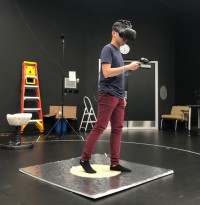
Here we propose a novel and cost-effective setup of a leaning-based interface (“NaviBoard”) that allows people to efficiently navigate virtual environments — with performance levels matching the gold standard of free-space walking, without any increase in motion sickness
Abstract Walking has always been the most common locomotion mode for humans in the real world. As a result, it has also been considered as the gold standard in a large body of Virtual Reality research involving navigation. Physical walking provides body-based sensory information (e.g., kinesthetic, proprioceptive, vestibular) about both translational and rotational components of locomotion. Though full rotation is no longer a technical challenge with recent advancements in tracking technology, physical translation is still restricted through limited tracked areas, which are also associated with many other constraints, e.g., cost, safety, cable, space requirement, and computational power. From the scientific perspective, while the rotational information has been shown to be important for several spatial tasks, the benefit of the translational component is still unclear with mixed results from previous studies. For these reasons, we conducted a mixed-method experiment to investigate how providing different levels of translational body-based sensory information associated with different locomotion interfaces might improve performance, and how close it could get to actual walking. We compared four levels of translational body-based information: none (participants using the trackpad of the HTC Vive wand controller to visually translate), upper-body leaning (participants sitting on a Swopper chair, leaning their upper-body to control their visual translation), whole-body leaning (participants standing on a platform called NaviBoard, leaning their whole body or stepping one foot off center to navigate the virtual environment), and full translational information (participants physically walking). In each condition, participants wore a head-mounted display and performed a navigational search task. Results showed that the translational information had significant effects on various measures including task performance, task load, and simulator sickness. While participants performed significantly worse when they used a controller with no translational body-based information, compared to the other conditions, there was no significant difference between the leaning-based interfaces and actual walking. Moreover, participants perceived significantly less motion sickness and task load in the NaviBoard and Walking conditions. These results suggested that translational body-based information from a leaning-based interface might provide a cost-effective alternative to actual walking in spatial cognition research and applications in VR.
Here’s Bernhard’s presentation of this paper at IEEE VR 2020:

Here’s a video explaining the experiment:

 [mediatags]??
[mediatags]??